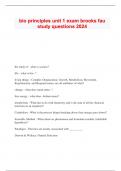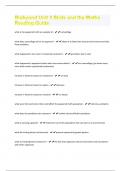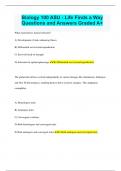Peppered - Study guides, Class notes & Summaries
Looking for the best study guides, study notes and summaries about Peppered? On this page you'll find 131 study documents about Peppered.
Page 2 out of 131 results
Sort by

-
bio principles unit 1 exam brooks fau study questions 2024
- Exam (elaborations) • 6 pages • 2024
- Available in package deal
-
- $12.49
- + learn more
the study of - what is science? life - what is bio- ? living things - Complex Organization, Growth, Metabolism, Movement, Reproduction, and Responsiveness are all attributes of what? change - what does mean meta- ? free energy - what does -bolism mean? metabolism - What has to do with chemistry and is the sum of all the chemical reactions in an organism? Catabolism - What is the process things breaking down (free energy goes down)? Scientific Method - What observes phenomena...

-
Solar System - Science Olympiad Questions and Answers Rated A+
- Exam (elaborations) • 31 pages • 2024
- Available in package deal
-
- $10.49
- + learn more
Solar System - Science Olympiad Questions and Answers Rated A+ How did the terrestrial planets form? In the proto-Solar-Sytem, after the sun formed, the rest of the materials orbiting close around it began to clump together too. However, closer to the sun, lighter materials like gases blew away and only rocky material was left, causing the four terrestrial planets, and some of their moons, to form. What are the characteristics of Terrestrial Planets? Solid bodies with a core surrounded...

-
Biology 1108 Unit 1 EXAM Questions and Answers 100% Pass
- Exam (elaborations) • 28 pages • 2024
-
- $12.49
- + learn more
Biology 1108 Unit 1 EXAM Questions and Answers 100% Pass The term "n" refers to the size of a population, that is, the number of individuals in that population. In general, in a sample of n individuals, the frequency of an allele is: A)the number of occurrences of the allele. B)the number of occurrences of the allele divided by n. C)the actual value of n D)the number of occurrences of the allele divided by twice the number of individuals in the sample (2n). E)twice the number of occur...

-
Biobeyond Unit 3 Birds and the Moths Reading Guide | 100% Correct Answers | Verified | Latest 2024 Version
- Exam (elaborations) • 2 pages • 2024
-
- $7.99
- + learn more
what is the peppered moth an example of - camouflage what does camouflage do for an organism? - allows it to blend into natural environment and hide from predators what happened to tree color in industrial revolution? - got darker due to soot what happened to peppered moths when trees were darker? - less camouflage, got eaten more, more black moths reproduced (carbonaria) increase in factories impact on carbonaria - increase increase in factories impact on typica - decrease increase in f...

-
Biology 1108 Final Exam Quiz Questions with 100% pass
- Exam (elaborations) • 15 pages • 2024
- Available in package deal
-
- $12.49
- + learn more
Biology 1108 Final Exam Quiz Questions with 100% pass The term "n" refers to the size of a population, that is, the number of individuals in that population. In general, in a sample of n individuals, the frequency of an allele is: - Correct Answer ️️ -the number of occurrences of the allele divided by twice the number of individuals in the sample (2n) If a population is not in Hardy-Weinberg equilibrium, we can conclude that: - Correct Answer ️️ -evolution has occurred because on...

-
Biology 1108 Unit 1 EXAM Questions and Answers 100% Pass
- Exam (elaborations) • 28 pages • 2024
- Available in package deal
-
- $13.49
- + learn more
Biology 1108 Unit 1 EXAM Questions and Answers 100% Pass The term "n" refers to the size of a population, that is, the number of individuals in that population. In general, in a sample of n individuals, the frequency of an allele is: A)the number of occurrences of the allele. B)the number of occurrences of the allele divided by n. C)the actual value of n D)the number of occurrences of the allele divided by twice the number of individuals in the sample (2n). E)twice the number of occur...

-
WGU C451/GNC2/1NC1 Integrated Natural Sciences Module 8 | Questions with 100% Correct Answers | Verified | Latest Update
- Exam (elaborations) • 9 pages • 2023
- Available in package deal
-
- $11.49
- + learn more
Explain the concept of natural selection. - It is a process where organisms with advantageous traits leave more offspring than organisms with other traits - causing populations to change over time. (key mechanism of evolution) variation - traits vary from individual to individual heritable traits - A trait that can be passed on genetically from parent to offspring. fitness - the number of offspring an organism leaves over its lifetime compared to other individuals in the population Descri...

-
Biobyond Unit 3 Birds and the Moths Reading Guide Rated 100% Correct!!
- Exam (elaborations) • 2 pages • 2023
- Available in package deal
-
- $2.99
- + learn more
what is the peppered moth an example of - camouflage what does camouflage do for an organism? - allows it to blend into natural environment and hide from predators what happened to tree color in industrial revolution? - got darker due to soot what happened to peppered moths when trees were darker? - less camouflage, got eaten more, more black moths reproduced (carbonaria) increase in factories impact on carbonaria - increase increase in factories impact on typica - decrease increase in f...

-
Biology 100 ASU - Life Finds a Way Questions and Answers Graded A+
- Exam (elaborations) • 5 pages • 2024
-
- $9.99
- + learn more
Biology 100 ASU - Life Finds a Way Questions and Answers Graded A+ What characterizes natural selection? A) Development of traits enhancing fitness B) Differential survival and reproduction C) Survival based on strength D) Selection for optimal phenotype B) Differential survival and reproduction The prehensile tail has evolved independently in various lineages like chameleons, kinkajous, and New World monkeys, enabling them to thrive in forest canopies. This adaptation exemplifies: ...

-
Bio unit 3 pt 4 Questions and Answers Already Graded A
- Exam (elaborations) • 9 pages • 2023
- Available in package deal
-
- $9.99
- + learn more
Bio unit 3 pt 4 Questions and Answers Already Graded A Select only the best answer. The moth was harder for predators to see Select all that apply. the luna moth would be easier for predators to see than the peppered moth the predator would eat the luna moth What effect do you think this would have on the trees that the peppered moth rested on? the trees would become darker in color What effect would the change in bark color on the trees have on the ability of the peppered moth to camouflage...

Do you wonder why so many students wear nice clothes, have money to spare and enjoy tons of free time? Well, they sell on Stuvia! Imagine your study notes being downloaded a dozen times for $15 each. Every. Single. Day. Discover all about earning on Stuvia


